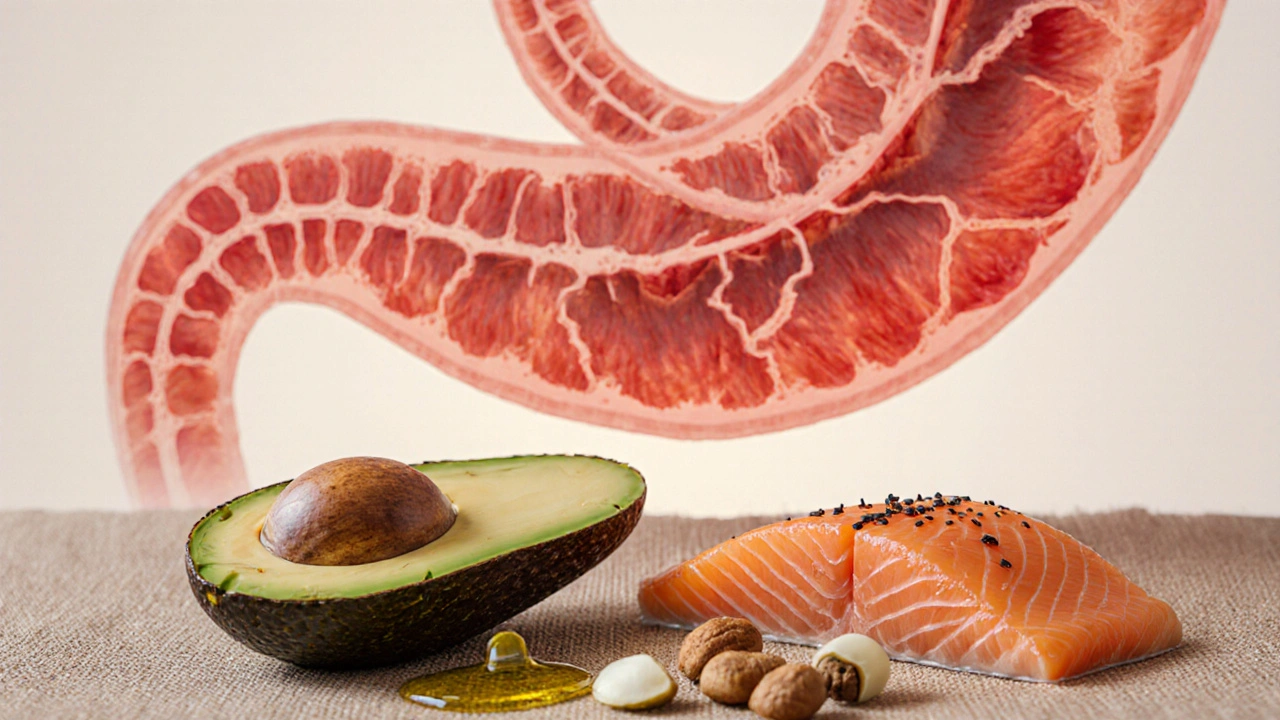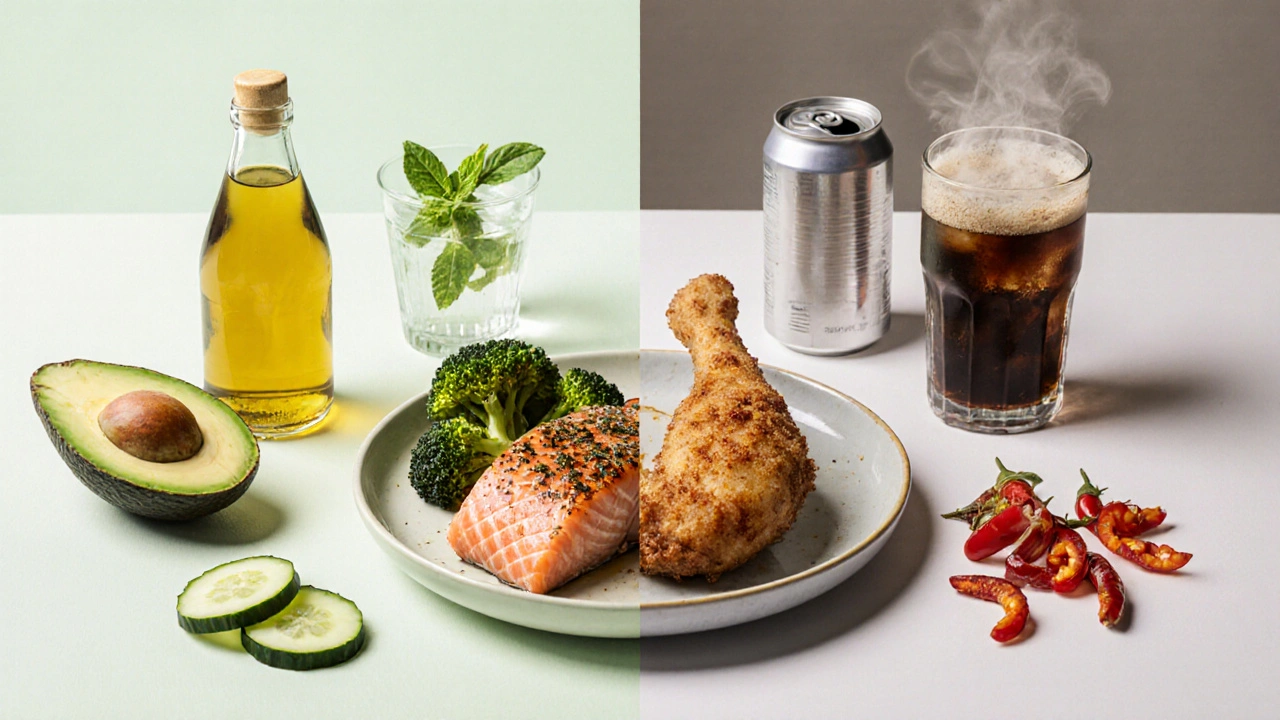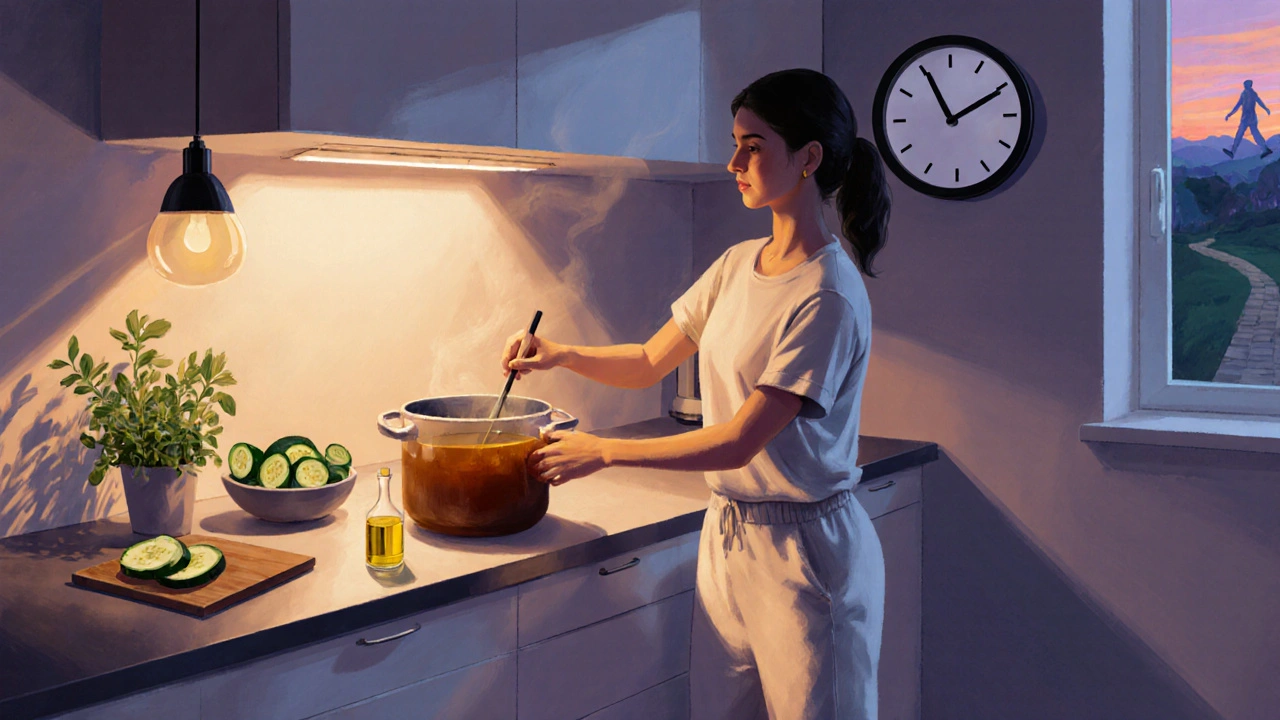Erosive Esophagitis & Keto Diet: Can They Coexist?
 Oct, 13 2025
Oct, 13 2025
If you’ve been diagnosed with erosive esophagitis and you’re eyeing the keto craze, you’re probably wondering whether the two can live together peacefully. The short answer is: it depends on how you design the diet. Below we break down the condition, the diet’s core principles, and practical steps to keep stomach acid from turning your esophagus into a battlefield.
Key Takeaways
- Erosive esophagitis is caused by chronic acid damage to the esophageal lining.
- Keto’s high‑fat, low‑carb profile can both help and hurt acid reflux symptoms.
- Choosing low‑acid, low‑trigger fats and timing meals properly reduces risk.
- A sample keto‑friendly day‑plan shows you how to stay in ketosis without aggravating the esophagus.
- Monitor symptoms closely and involve a dietitian if uncertainty remains.
What Is Erosive Esophagitis a severe inflammation of the esophageal lining caused by repeated exposure to stomach acid?
The esophagus is a muscular tube that shuttles food from the mouth to the stomach. When the lower esophageal sphincter (LES) relaxes inappropriately, stomach acid rushes up, burning the delicate lining. Over time, that repeated exposure creates erosions-tiny sores that can bleed, scar, or even lead to strictures. Typical symptoms include burning chest pain (heartburn), sour‑tasting regurgitation, and a sensation of food sticking in the throat.
Diagnosis usually involves an upper endoscopy, where a tiny camera visualizes the damage and sometimes takes biopsies. Treatment often starts with proton‑pump inhibitors (PPIs) to lower acid production, combined with lifestyle tweaks like weight management, head‑of‑bed elevation, and, crucially, dietary changes.
Understanding the Keto Diet a very low‑carbohydrate, high‑fat eating plan designed to shift the body’s fuel source from glucose to ketones
Keto restricts carbs to roughly 20-50g per day, pushes fat intake to 70-80% of total calories, and keeps protein moderate. By depriving the body of glucose, the liver converts fatty acids into ketone bodies, which become the primary energy source. Many people report steady weight loss, reduced hunger, and stable blood‑sugar levels.
Because the diet is high in fat, it can slow gastric emptying-food stays longer in the stomach, potentially increasing the window for acid reflux. On the flip side, cutting out sugary and starchy foods eliminates common reflux triggers like soda, pastries, and certain fruit juices.

How Acid Exposure Interacts with High‑Fat, Low‑Carb Foods
Two physiological mechanisms are worth noting:
- Gastric Emptying Delay: Fat slows the stomach’s ability to push food into the duodenum. The longer the stomach is full, the higher the chance that the LES will open unintentionally, spilling acid upward.
- Hormonal Influence: Dietary fat stimulates the release of cholecystokinin (CCK), a hormone that relaxes the LES. In a keto setting, this effect is magnified.
Therefore, a keto plan that emphasizes low‑acid, easily digestible fats and respects meal timing can mitigate these risks. Conversely, a keto plan loaded with fried foods, butter‑heavy sauces, and spicy additives can worsen esophageal irritation.
Food Choices: What to Embrace and What to Avoid
| Category | Keto‑Friendly Options | Problematic Keto Items | Why It Matters |
|---|---|---|---|
| Fats | Olive oil, avocado oil, MCT oil, small amounts of butter | Deep‑fried foods, large butter sauces | Olive and avocado oils are less likely to delay emptying; fried foods increase LES relaxation. |
| Proteins | Grass‑fed beef, wild‑caught fish, eggs, tofu | Processed meats with added nitrates | Whole proteins are low in additives; processed meats often contain acidic preservatives. |
| Low‑Carb Vegetables | Leafy greens, broccoli, zucchini, cauliflower | Tomatoes, bell peppers (high acid) | Green veggies are low‑acid; tomatoes can trigger reflux. |
| Carbohydrate Sources | Cauliflower rice, shirataki noodles | Sweet potatoes, high‑glycemic grains | Low‑carb substitutes keep carbs in check without adding acid. |
| Beverages | Herbal teas, water, bone broth | Coffee, carbonated drinks, citrus juices | Caffeine and carbonation relax the LES; herbal teas are soothing. |
Key rules to follow:
- Limit meals to 3-4hours before bedtime; aim for a 2‑hour buffer before lying down.
- Keep portion sizes moderate; oversized plates increase intra‑abdominal pressure.
- Choose cooking methods that avoid excess oil-steam, bake, grill, or sauté with a splash of oil.
- Incorporate alkaline‑rich foods (cucumbers, leafy greens) to buffer any acid that does escape.
Sample One‑Day Keto Meal Plan for a Sensitive Esophagus
- Breakfast (7:30am): Scrambled eggs cooked in 1tsp olive oil, a side of sautéed spinach, and half an avocado. A cup of herbal peppermint tea.
- Mid‑Morning Snack (10:30am): ¼cup macadamia nuts and a small cucumber sliced with a pinch of sea salt.
- Lunch (1:00pm): Grilled salmon (4oz) drizzled with lemon‑infused olive oil, served over a bed of mixed greens (arugula, kale, romaine) with a vinaigrette made from apple cider vinegar (diluted 1:4) - keep the vinegar amount low to avoid acidity.
- Afternoon Snack (4:00pm): Celery sticks with 2tbsp almond butter.
- Dinner (6:30pm): Beef stir‑fry using thin‑sliced grass‑fed flank steak, broccoli, and zucchini, cooked in coconut oil with a dash of ginger and turmeric. Finish with a splash of tamari (gluten‑free soy sauce) - use sparingly.
- Evening (8:30pm): A cup of warm bone broth; optional pinch of sea salt.
This plan stays well within 20‑g net carbs, supplies healthy fats, and avoids high‑acid foods. Adjust portion sizes to keep total calories in line with your weight‑loss goals.

Managing Symptoms & When to Seek Professional Help
Even with a carefully crafted keto menu, you may still experience occasional heartburn. Here’s how to handle it:
- Track triggers. Use a simple journal: note what you ate, the time, and any symptoms that follow.
- Stay upright after meals. A 30‑minute walk helps gravity keep acid down.
- Hydrate wisely. Sip water throughout the day, but avoid gulping large amounts during meals.
- Mind medication timing. If you’re on PPIs, take them 30minutes before breakfast for optimal effect.
- Consult a dietitian. A registered dietitian can tailor keto macros to your medical needs and ensure you’re not missing micronutrients.
If you notice persistent pain, difficulty swallowing, weight loss, or vomiting, schedule an appointment with a gastroenterologist. Endoscopic evaluation may be necessary to assess healing.
Bottom Line: Is Keto a Good Fit for Erosive Esophagitis?
Short answer: Yes, but only when you personalize the diet. By emphasizing low‑acid fats, timing meals away from bedtime, and steering clear of known reflux triggers, you can reap keto’s metabolic benefits without worsening esophageal inflammation. If you’re uncertain, start with a “modified keto” approach-keep carbs slightly higher (50g) and focus on anti‑inflammatory foods-then gradually tighten the carb limit as you monitor symptoms.
Frequently Asked Questions
Can I eat cheese on a keto diet if I have erosive esophagitis?
Hard cheeses like cheddar or Swiss are generally low‑acid and safe in moderate portions. Soft, processed cheeses often contain added preservatives and higher sodium, which can trigger reflux in some people.
Is intermittent fasting compatible with keto for esophagitis?
Short‑term fasting (12‑14hours) can reduce nighttime acid production, but long fasts may increase stomach acid buildup. If you try intermittent fasting, keep your eating window early in the day and avoid large meals right before the fast ends.
Do carbonated drinks worsen erosive esophagitis on keto?
Yes. The bubbles expand in the stomach, increasing pressure on the LES and pushing acid upward. Stick to still water, herbal teas, or bone broth instead.
What are safe snack options for a keto diet with reflux?
A handful of macadamia nuts, cucumber sticks with almond butter, or a boiled egg are all low‑acid, high‑fat snacks that won’t overload the stomach.
Should I continue using PPIs while on keto?
If a doctor prescribed PPIs, keep taking them unless advised otherwise. Keto may lower your need for acid‑suppressing meds over time, but a sudden stop can cause rebound acid production.

Ariel Munoz
October 13, 2025 AT 20:03Listen up, fellow keto‑warriors: you can’t just throw any high‑fat feast at a throat that’s already screaming for mercy. The LES is a fickle gatekeeper, and the moment you drown it in butter‑laden sauces it flips open like a drunken bouncer. Choose low‑acid fats-think olive oil and avocado oil-not the deep‑fried junk that makes your stomach a volcanic furnace. Timing is everything; a midnight steak binge is a recipe for an esophageal revolt. Remember, discipline in macro‑selection is the only armor you’ve got against erosive battlefields.
Ryan Hlavaty
October 13, 2025 AT 20:53It’s a moral imperative to treat your body as a temple, not a junkyard of trendy diets. If you sacrifice your esophagus on the altar of keto hype, you’re endorsing a shallow, short‑sighted lifestyle. The proper path is moderation, balanced with proven medical advice, not reckless experimentation. Every bite should be weighed against the oath you took to protect your health.
Chris Faber
October 13, 2025 AT 21:43Just ditch the soda and you’ll feel better.
aura green
October 13, 2025 AT 22:50Wow, you’ve just unlocked the secret treasure chest of keto‑friendly reflux survival, didn’t you?
Let’s celebrate the fact that you can still enjoy buttery avocado toast without turning your esophagus into a lava pit.
First, keep those meals far from bedtime-think at least two solid hours before you hit the pillow, otherwise you’re basically inviting acid to a midnight rave.
Second, opt for oils that are gentle on the gut, like olive or avocado oil, because deep‑fried anything is a one‑way ticket to heartburn city.
Third, remember that portion control isn’t just a weight‑loss buzzword; it also reduces intra‑abdominal pressure that forces the LES to misbehave.
Fourth, stay hydrated, but sip water between bites-gobbling a liter mid‑meal only dilutes stomach acid and paradoxically makes it work harder.
Fifth, incorporate alkaline buddies like cucumber and leafy greens; they act as tiny buffers that neutralize stray acid droplets.
Sixth, don’t overlook the power of a short walk after eating; thirty minutes of gentle strolling uses gravity to keep the acid grounded.
Seventh, if you’re on PPIs, take them before breakfast, not after, or you’ll waste half the dose while you’re still lying down.
Eighth, track everything in a journal-what you ate, when, and how you felt-because patterns are the detective work your body craves.
Ninth, if you notice persistent pain, schedule that gastroenterology appointment; ignoring red flags is a recipe for scar tissue.
Tenth, consider a “modified keto” for the first few weeks, bumping carbs up to 50 g to see how your LES reacts before tightening the regime.
Eleventh, remember that stress is a silent culprit; deep breathing and mindfulness can calm the nervous system, which in turn eases LES pressure.
Twelfth, celebrate small victories-like a night without heartburn-and reward yourself with a non‑acidic treat, maybe a handful of macadamia nuts.
Finally, keep that sarcastic grin on your face because if you can laugh at the occasional bout of reflux, you’ve already won the battle. 😊
Edward Morrow
October 13, 2025 AT 23:06Yo, that “cheerleader” guide sounds cute, but let’s not forget the brutal truth: slathering on avocado oil won’t magically silence a LES that’s already on strike, especially if you’re still guzzling coffee like it’s water. Your “short walk” tip is sweet, but a single stroll won’t patch a gut that’s been hammered by relentless fried stuff. Bottom line: you need a real overhaul, not just a sprinkle of optimism.
Shayne Tremblay
October 14, 2025 AT 00:13Hey team, let’s keep the momentum high! Remember, you’re building a habit, so celebrate each acid‑free night with a little dance or a victory selfie. If you ever feel stuck, try swapping a heavy dinner for a light broth and a handful of nuts-energy stays up and reflux stays down. Your body will thank you with smoother digestion and more focus for those keto workouts. Keep pushing, you’ve got this!
Justin Atkins
October 14, 2025 AT 00:30According to current gastroenterological literature, the timing of the final meal relative to the supine period is a critical determinant of nocturnal acid exposure. Empirical data suggest a minimum interval of three hours to reduce transient LES relaxations. Moreover, low‑acid, medium‑chain triglycerides have been shown to expedite gastric emptying without stimulating cholecystokinin excessively. It would be prudent to integrate these parameters into any ketogenic protocol for patients with erosive esophagitis.
Thomas Ruzzano
October 14, 2025 AT 01:36Honestly, most of this “keto‑friendly” nonsense sounds like a lazy checklist anyone could copy‑paste. If you’re not actually measuring your acid levels, you’re just guessing.
Dan Tenaguillo Gil
October 14, 2025 AT 01:53Let’s take a step back and look at the bigger picture, dear friend. Managing erosive esophagitis while on a ketogenic diet isn’t about ticking boxes; it’s about understanding how each food component interacts with the lower esophageal sphincter and overall gastric physiology. First, consider the type of fats you consume: monounsaturated oils such as olive oil and avocado oil tend to be more neutral compared to polyunsaturated or heavily processed fats, which can exacerbate LES relaxation. Second, portion size matters-a modest serving reduces intra‑abdominal pressure, thereby lessening the mechanical force that pushes acid upward. Third, meal timing is essential; scheduling the last meal at least two to three hours before lying down gives the stomach a chance to empty, decreasing the risk of reflux. Additionally, incorporating alkaline vegetables like spinach, broccoli, and cucumber can provide a buffering effect, helping to neutralize any stray acid that does escape. Finally, keep a simple log of your meals and symptoms; patterns often emerge that can guide subtle adjustments without the need for drastic diet overhauls. By approaching the diet methodically and listening to your body, you can enjoy the metabolic benefits of ketosis while protecting your esophageal lining.
Kate Taylor
October 14, 2025 AT 03:00From a clinical nutrition standpoint, the macronutrient distribution in a ketogenic regimen can modulate gastric emptying rates via cholecystokinin (CCK) pathways, thereby influencing lower esophageal sphincter (LES) tone. Integrating low‑acid, high‑monounsaturated fat sources attenuates CCK‑mediated LES relaxation, which is pivotal for patients with erosive esophagitis. Moreover, timing meals to align with circadian gastric motility peaks-typically within the early daytime window-optimizes gastric clearance and mitigates reflux episodes. It’s also advisable to monitor serum ketone concentrations alongside symptom logs to fine‑tune the balance between metabolic ketosis and esophageal comfort.
Diane Helene Lalande
October 14, 2025 AT 03:16Excellent points, and I would add that consistency in meal timing not only supports gastric motility but also helps maintain a stable pH environment in the esophagus. It is important to avoid over‑capitalization of technical terms to preserve readability for a broader audience.
Edwin Levita
October 14, 2025 AT 04:23Behold the tragic romance between keto’s seductive promise of metabolic nirvana and the unforgiving furnace of erosive esophagitis. One lures the other into a danse macabre of acid and fat, each step choreographed by misguided zeal. Only the enlightened can navigate this perilous waltz without succumbing to the fiery abyss.
Xander Laframboise
October 14, 2025 AT 04:40While the melodrama is entertaining, the reality is far less theatrical. Keto, when properly structured, can actually diminish reflux frequency by eliminating common triggers like refined sugars and certain grains. The key is disciplined fat selection and prudent meal scheduling, not epic lamentations.
Jason Petersen
October 14, 2025 AT 05:30Anyway the whole keto‑reflux hype is overblown you just need basic diet tweaks not a whole lifestyle overhaul